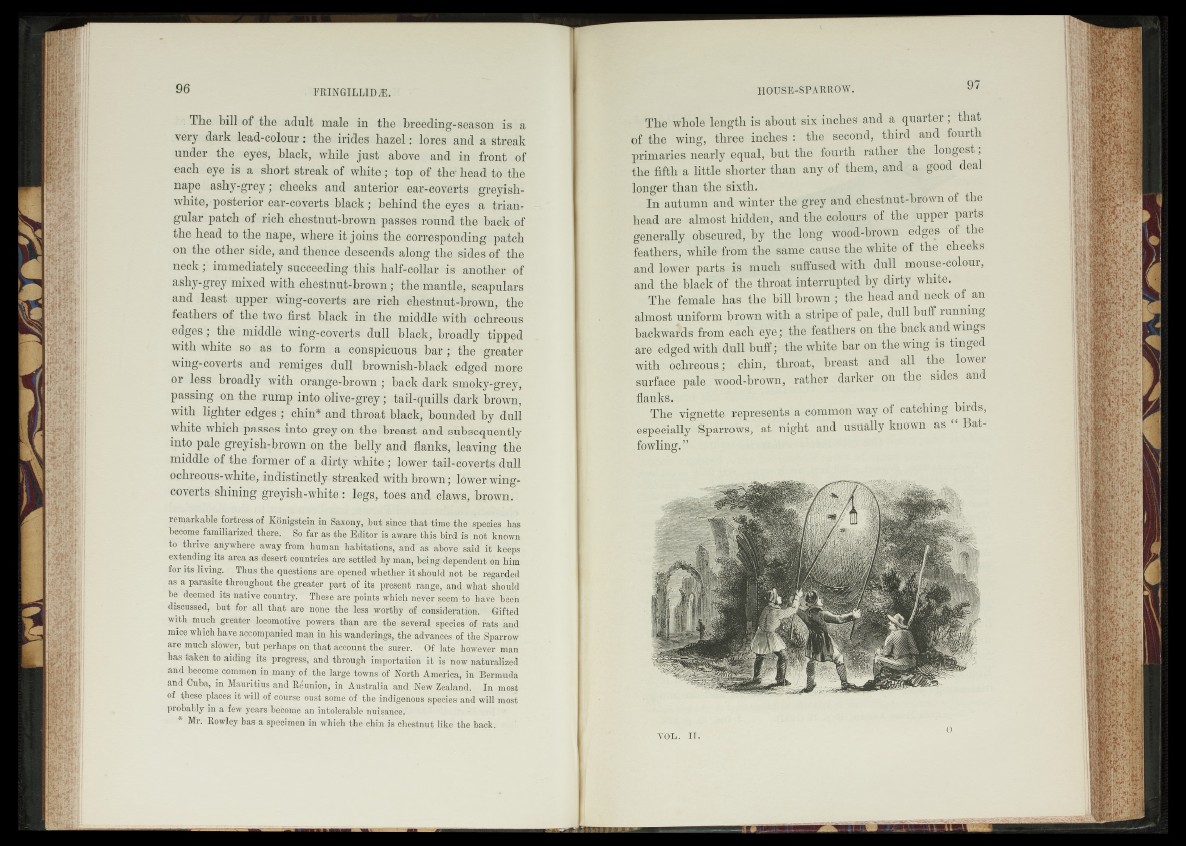
The bill of the adult male in the breeding-season is a
very dark lead-colour: the irides hazel: lores and a streak
under the eyes, black, while just above and in front of
each eye is a short streak of white; top of the' head to the
nape ashy-grey; cheeks and anterior ear-coverts greyish-
white, posterior ear-coverts black ; behind the eyes a triangular
patch of rich chestnut-brown passes round the back of
the head to the nape, where it joins the corresponding patch
on the other side, and thence descends along the sides of the
neck; immediately succeeding this half-collar is another of
ashy-grey mixed with chestnut-brown; the mantle, scapulars
and least upper wing-coverts are rich chestnut-brown, the
feathers of the two first black in the middle with ochreous
edges ; the middle wing-coverts dull black, broadly tipped
with white so as to form a conspicuous bar ; the greater
wing-coverts and remiges dull brownish-black edged more
or less broadly with orange-brown ; back dark smoky-grey,
passing on the rump into olive-grey; tail-quills dark brown,
with lighter edges ; chin* and throat black, bounded by dull
white which passes into grey on the breast and subsequently
into pale greyish-brown on the belly and flanks, leaving the
middle of the former of a dirty white ; lower tail-coverts dull
ochreous-white, indistinctly streaked with brown; lower wing-
coverts shining greyish-white : legs, toes and claws, brown.
remarkable fortress of Konigstein in Saxony, but since that time the species has
become familiarized there. So far as the Editor is aware this bird is not known
to thrive anywhere away from human habitations, and as above said it keeps
extending its area as desert countries are settled by man, being dependent on him
for its living. Thus the questions are opened whether it should not be regarded
as a parasite throughout the greater part of its present range, and what should
be deemed its native country. These are points which never seem to have been
discussed, but for all that are none the less worthy of consideration. Gifted
with much greater locomotive powers than are the several species of rats and
mice which have accompanied man in his wanderings, the advances of the Sparrow
are much slower, but perhaps on. that account the surer. Of late however man
has taken to aiding its progress, and through importation it is now naturalized
and become common in many of the large towns of North America, in Bermuda
and Cuba, in Mauritius and Reunion, in Australia and New Zealand. In most
of these places it will of course oust some of the indigenous species and will most
probably in a few years become an intolerable nuisance.
* Mr. Rowley has a specimen in which the chin is chestnut like the back.
The whole length is about six inches and a quarter; that
of the wing, three inches : the second, third and fourth
primaries nearly equal, but the fourth rather the longest,
the fifth a little shorter than any of them, and a good deal
longer than the sixth.
In autumn and winter the grey and chestnut-brown of the
head are almost hidden, and the colours of the upper parts
generally obscured, by the long wood-brown edges of the
feathers, while from the same cause the white of the cheeks
and lower parts is much suffused with dull mouse-colour,
and the black of the throat interrupted by dirty white.
The female has the bill brown ; the head and neck of an
almost uniform brown with a stripe-of pale, dull buff running
backwards from each eye ; the feathers on the b a c k and wings
are edged with dull buff; the white bar on the wing is tinged
with ochreous; chin, throat, breast and all the lovei
surface pale wood-brown, rather darker on the sides and
flanks.
The vignette represents a common way of catching ^birds,
especially Sparrows, at night and usually known as “ Batfowling.”
VOL. IT.